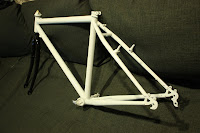kmxtornado
10 kW
Here I go again with newb questions. I know my front fork isn't disk brake compatible, but what about the rear? Here's a shot of my rear dropout.
Ebike:

Larger photo here: http://1.bp.blogspot.com/-dQiNyr5R2iY/TrjvaI6SWyI/AAAAAAAABz0/kAVIF_Dczck/s1600/IMG_0890.JPG
Restoration bike:

Larger photo here: http://1.bp.blogspot.com/-ZBt6fwRFSW0/TsC_1gCQvrI/AAAAAAAAB-o/J21nY0t1Ad8/s1600/IMG_0955.JPG
1. I suspect that the hole being used for the white rear trunk rack and the empty one are for mounting a disk brake caliper. Is that correct?
2. Is it weird to have a disk brake in the back and a standard one in the front? Anyone else have a setup like that?
I contacted A2Z who fabricate adapters and stuff like that for mounting disk brake systems, but they weren't very helpful. They kept telling me their stuff is only for alloy frames and not steel. Firstly, they don't know mine is steel and secondly it makes more sense that disk brakes are mounted on steel frames since a majority of mountain bikes are built out of this material, right? They kept referring to my rear dropout as a fork. Shows what they know. Ugh.
Ebike:
Larger photo here: http://1.bp.blogspot.com/-dQiNyr5R2iY/TrjvaI6SWyI/AAAAAAAABz0/kAVIF_Dczck/s1600/IMG_0890.JPG
Restoration bike:
Larger photo here: http://1.bp.blogspot.com/-ZBt6fwRFSW0/TsC_1gCQvrI/AAAAAAAAB-o/J21nY0t1Ad8/s1600/IMG_0955.JPG
1. I suspect that the hole being used for the white rear trunk rack and the empty one are for mounting a disk brake caliper. Is that correct?
2. Is it weird to have a disk brake in the back and a standard one in the front? Anyone else have a setup like that?
I contacted A2Z who fabricate adapters and stuff like that for mounting disk brake systems, but they weren't very helpful. They kept telling me their stuff is only for alloy frames and not steel. Firstly, they don't know mine is steel and secondly it makes more sense that disk brakes are mounted on steel frames since a majority of mountain bikes are built out of this material, right? They kept referring to my rear dropout as a fork. Shows what they know. Ugh.

